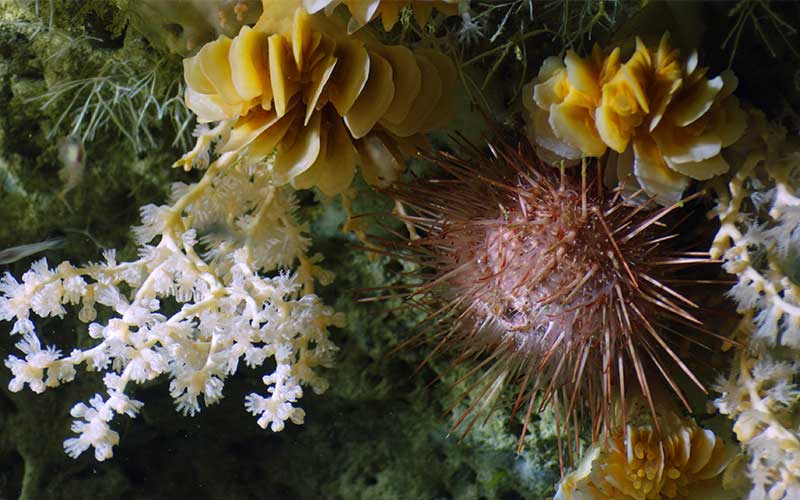
Some of the deep-sea corals in the Northeast Canyons and Seamounts Marine National Monument are more than 4,000 years old, making them some of the oldest known marine organisms. Photo: OceanX Bloomberg
It’s understandable if many New Englanders have never heard of the Northeast Canyons and Seamounts Marine National Monument. The monument, located about 130 miles off the coast of Cape Cod, is just a few years old. In fact, it was only in 2016 that President Obama designated it the first U.S. marine national monument in the Atlantic Ocean. In 2021, it received renewed protection from President Biden, who affirmed that the Canyons and Seamounts deserve to be protected permanently.
The Northeast Canyons and Seamounts Monument is known for its abundance of rare and common aquatic plant and animal species. Here are six fascinating facts to help you get to know one of New England’s ocean treasures.
1. It’s the first marine national monument in the U.S. Atlantic Ocean.
President Obama’s designation of the Northeast Canyons and Seamounts Marine National Monument means that harmful human activity, like commercial fishing and oil drilling, is off-limits in the area. (The last commercial fishing operations in the monument will wind down later this year.)
Right now, the Northeast Canyons and Seamounts is still the only marine national monument in the Atlantic — although it shouldn’t be the last! Plenty of other ocean areas in New England would benefit from this high level of protection.
2. There are underwater mountains, called seamounts, taller than Mt. Washington.
The monument includes four seamounts rising thousands of feet off the ocean floor. Bear Seamount is the tallest of the four at 9,800 feet — taller than Mt. Washington (a mere 6,288 feet by comparison.) Bear Seamount is an ancient formation that’s been around for 100 million years. Scientists estimate they’ve discovered only about half of the diverse marine life that makes its home on this seamount.
3. The canyons support so many species that they’re “keystone structures.”
“Keystone species” help hold an ecosystem together (think of a bee and its role as a pollinator in the food chain). Likewise, “keystone structures,” like the monument’s deep-cutting canyons, are critical hubs that support all kinds of life. Without these three canyons, the marine ecosystem in the area would change drastically. That’s because the canyons teem with tiny crustaceans called krill that can gather into dense swarms 100 feet thick. That density makes the canyons ideal feeding grounds for squid, whales, dolphins, sharks, and other marine life. On a good day, researchers at one canyon head reported seeing an array of species – from rare whales to dolphins to sea birds like storm petrels – all feeding on the abundant ocean prey.
4. More than 50 species of deep-sea corals thrive in the monument’s lower depths.
These deep-sea corals can survive thousands of feet below sea level where no sunlight reaches. Lacking the photosynthetic algae of their tropical counterparts, these cold-water corals grow very slowly, feeding on food particles from the water around them. Some are more than 4,000 years old, making them some of the oldest known marine organisms.
5. Scientists discover new species every time they explore more of the monument.
Researchers found two new species of deep-sea bubblegum corals in Lydonia Canyon just a few years ago. And there’s still much more of the monument to explore.
6. The monument supports wildlife in a changing ocean.
Protecting areas like the Northeast Canyons and Seamounts keeps such critical ecological gems safe from harm, helps them recover from past human disturbance, and gives marine life a space to thrive. Healthier habitats, in turn, improve ocean health, which can better support tourism, fishing, recreation, and other human activities. Highly protected areas also improve the ocean’s ability to absorb climate-damaging emissions like carbon dioxide from the atmosphere. They are vital to building resilience to the worst impacts of climate change.
For all these reasons and many more, the Northeast Canyons and Seamounts Marine National Monument is an extraordinary place that is now protected for generations to come. This national treasure is vital to a healthy ocean and withstanding the effects of climate change.



